Despite Walt’s dreams, his “Space Port” through the stars didn’t open with New Tomorrowland in 1967. And while that might’ve spelled the end for the concept, they do say that “good ideas never die at Disney…” Here’s exactly what they mean…
1. Magic Kingdom
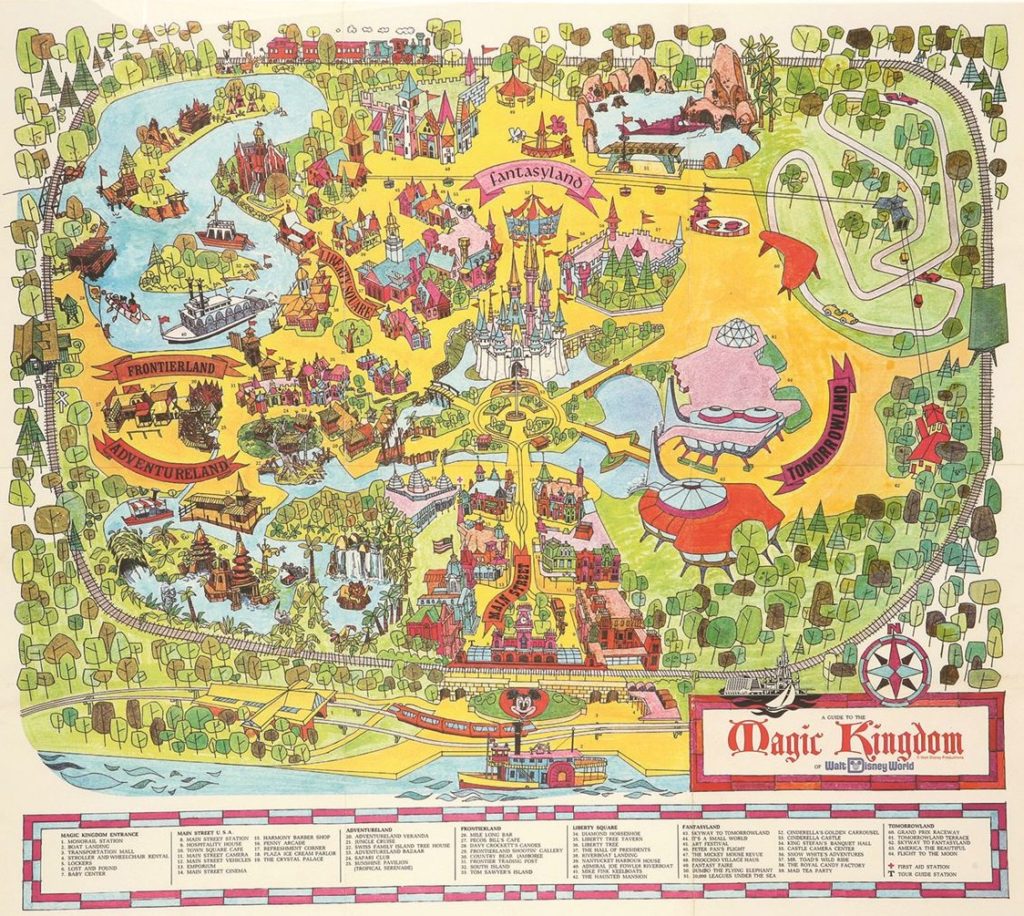
Space Mountain opened: 1975
When Magic Kingdom opened in 1971, designers had intentionally drafted the park differently than they had Disneyland. For one thing, Magic Kingdom was comparatively massive. While Disneyland was surrounded by an earthen berm to keep the outside world away, Magic Kingdom has no berm. It doesn’t need one. The park is placed in the northwestern corner of Disney’s San-Francisco-sized property in Florida, giving the park plenty of room to spread out with wide paths and plazas built for crowds.
But Imagineers also did some resetting for something else they expected to be different: who those crowds were composed of. It was believed that Walt Disney World would attract a fair share of adults without children. After all, while Disneyland was a fairytale playground, Walt Disney World was “The Vacation Kingdom of the World,” offering water skiing, hiking, boating, shopping, dining, and more with the theme park itself being just one part of the complex. As a result, Magic Kingdom opened with a heavy emphasis on theater attractions, placing them front-and-center in most lands.
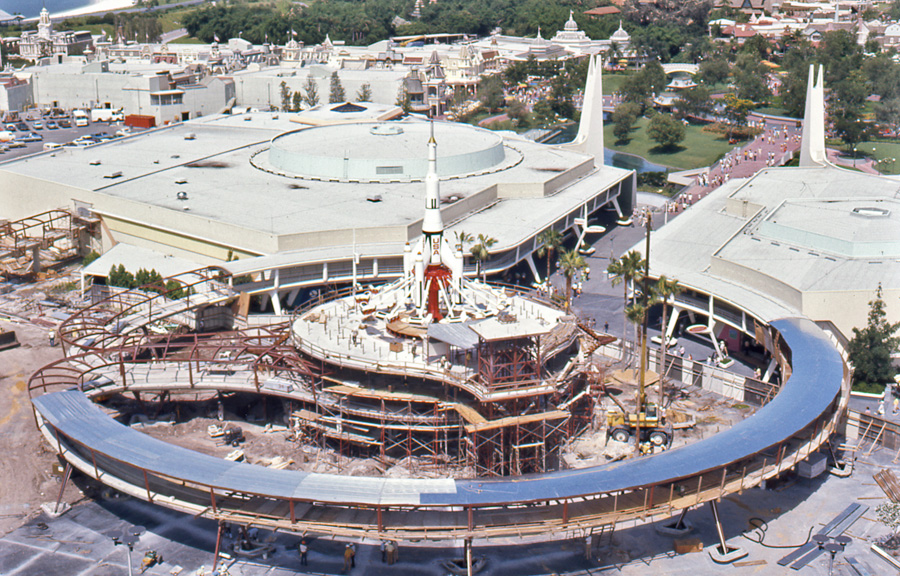
Take Tomorrowland. Just as with Disneyland 16 years earlier, designers had sort of fallen behind on Tomorrowland during the park’s construction. When Magic Kingdom opened, the main thoroughfare leading into Tomorrowland was about all the land contained other than the Lost Legend: The Skyway. And what was in those two mirrored showbuildings along the entry? Shows… The north contained Mission to Mars (the latest iteration of Disneyland’s original Rocket to the Moon) and the south held a CircleVision 360 theater.
This Tomorrowland wasnt complete at the park’s opening either. Soon after the park opened, an expansion got underway that would add the parks central pedestal from which the Peoplemover and Rocket Jets took off, and a custom-built revolving theater to receive the relocated Carousel show from Disneyland.
But as the story goes, Disney was surprised just how many of the families and adults that descended on Walt Disney World had older siblings in tow… pre-teens and teenagers who didn’t find too much to write home about in the intellectual park.

Luckily, the unexpected need for a thrill ride and Magic Kingdom’s undeveloped Tomorrowland coalesced with those old plans for a Space Port… The rare art above by Clem Hall shows a very different Space Mountain than the one we know, but it’s likely that this piece was merely an atmospheric study rather than an architectural one.
After all, the initial concepts from John Hench’s Space Port largely survived, just replacing the joyful and whimsical ’60s curves with with the more monumental, angular architecture of the ’70s (the same that would inspire EPCOT Center’s pavilions in the years that followed):
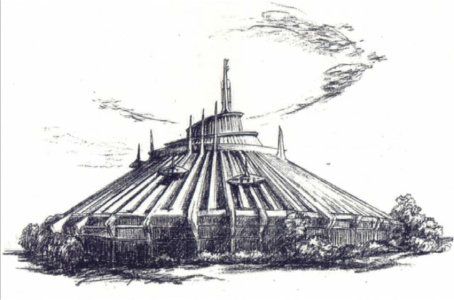
Disney Legends John Hench and Marty Sklar and CEO Card Walker set out to find a sponsor to underwrite the construction such an epic attraction. Electronics company RCA bought in, investing $10 million in the project in exchange for promotion. Construction on the ride began in 1972 – the start of a three year project.
Altogether, the “mountain” occupies over 80,000 square feet – one of Disney’s largest showbuildings ever. In fact, Space Mountain is so large, it was built outside of the park’s circumnavigating railroad. The massive, conical white tower reaches 183 feet high – just six feet shorter than Cinderella Castle.
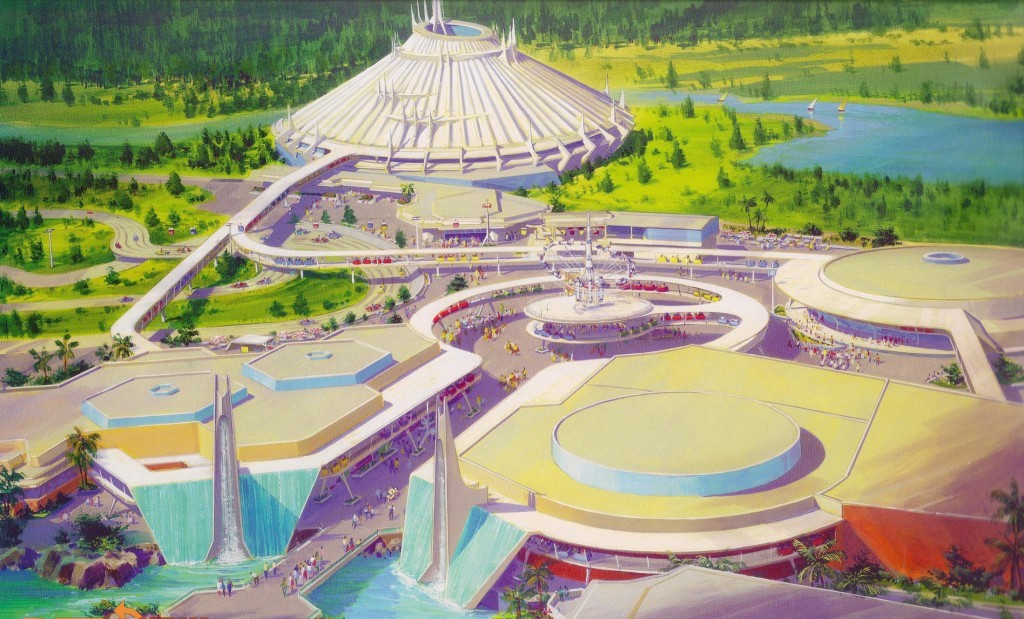
Magic Kingdom’s Space Mountain opened on January 15, 1975 as an official (if somewhat late…) launch of Tomorrowland, debuting alongside the park’s Peoplemover and the Modern Marvel: Carousel of Progress – relocated from Disneyland at the request of sponsor, General Electric. On board the first train dispatched was Colonel James Irwin – pilot of the Apollo XV Lunar Module. By the way, the $15 million attraction is said to have earned $25 million in revenue in its first four years by the cost of E-Tickets redeemed to ride it.
Like Matterhorn, Space Mountain is actually made of two side-by-side mirrored tracks (called “Alpha” and “Omega”). Also owing to its origins as a Matterhorn spin-off, guests are seated in “bobsled” style rockets with a single guest in each row – a historic test of bravery for generations of young Disney World visitors.
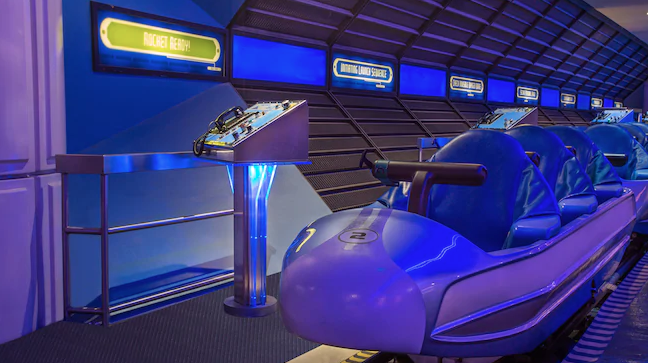
The ride begins memorably with trains being dispatched down a spiraling drop into pulsing power tunnels with a pitching warp sound and racing blue lights pulling back alongside the slow-coasting trains.
At the end of the energizing corridors, the train jerks around a 180-degree turn and aligns with parallel lift hills through a (distinctly ’70s) space station, with the PeopleMover memorably gliding directly between the two en route to its inside look at Space Mountain.
At the crest of the lift hill, the coaster begins its spiraling, “wild mouse” style descent through the black interior lit by projections and reflections of stars, twisting and turning through the dome.
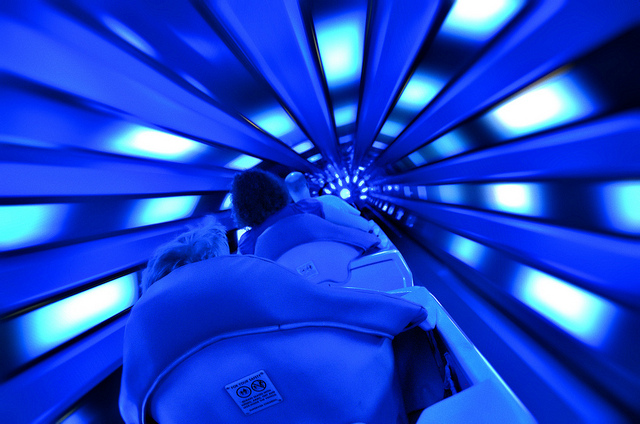
Despite ineviatable childhood memories, Space Mountain’s maximum speed as it races through the course is only 27 miles per hour – the speed limit in most residential neighborhoods. But the brilliance of Space Mountain is in its illusion. With stars flying past and the inability to see (and brace for) upcoming turns, the ride feels like a wild, sensational, breathless race through outer space. Finally, a swirling red wormhole tunnel signals a return to Earth as the trains pull into an underground loading dock.
To recap, the “Space Port” imagined for Disneyland as far back as 1964 had come to life a full decade later, but in Magic Kingdom. However, the success of the Floridian ride made the idea of a duplication in California sound like a surefire hit.
2. Disneyland
Space Mountain opened: 1977
With Space Mountain acting as a new headlining E-Ticket for Walt Disney World, it was inevitable that the interstellar roller coaster would make it ways back to Disneyland. However, there was a problem… Magic Kingdom’s Space Mountain was closely modeled off of the Matterhorn with its doubled, side-by-side, diverging coaster circuits. Of course, that wouldn’t work at Disneyland, where Matterhorn was already a favorite.
Space Mountain would need redesigned not only to bring an original experience to Disneyland, but to accomodate for the park’s small size. California’s peak would be 2/3 the size of Florida’s, with a 200 foot diameter mountain built on an expansion pad between Tomorrowland and Main Street (originally planned for the never-built Edison Square, and later housing the failed Flying Saucers).
Designers also “sank” Disneyland’s mountain 17 feet into the ground to keep the peak from throwing off the park’s subtler scale, where it would’ve dominated Main Street.
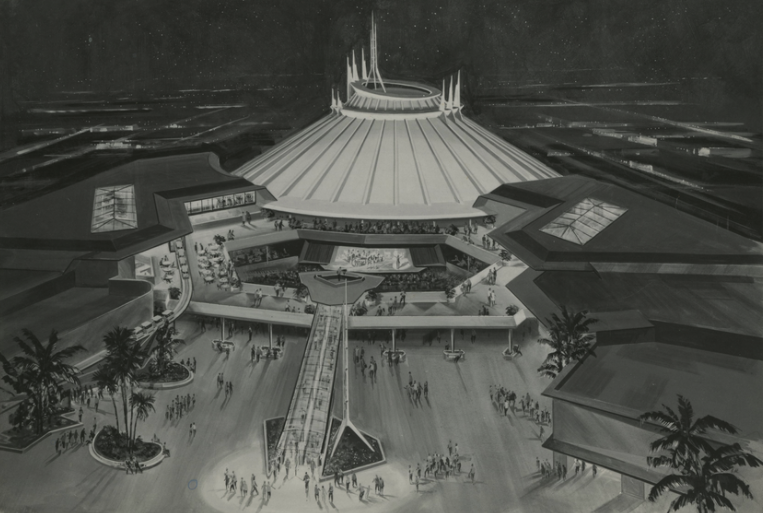
Since this Space Mountain would need to fit within the park’s berm, it was nestled among showbuildings with the newly-enclosed 3D Magic Eye Theater set directly in front of it. Guests ascend to the theater’s roof, then step directly into the side of the mountain. From there, winding metallic corridors descend into the core of the mountain, eventually emerging in a cavernous space station with wisps of starlight zooming past outside.

Balconies clinging to the perimeter of the hangar gradually lead guests down to the ride’s loading are beneath a docked starship. Disneyland’s rockets resemble traditionally coaster trains: side-by-side seating, carrying 12-guests per train.
Disneyland’s Space Mountain is entirely unique from Magic Kingdom’s both in its single-track layout custom-designed for the park and its upgrades…
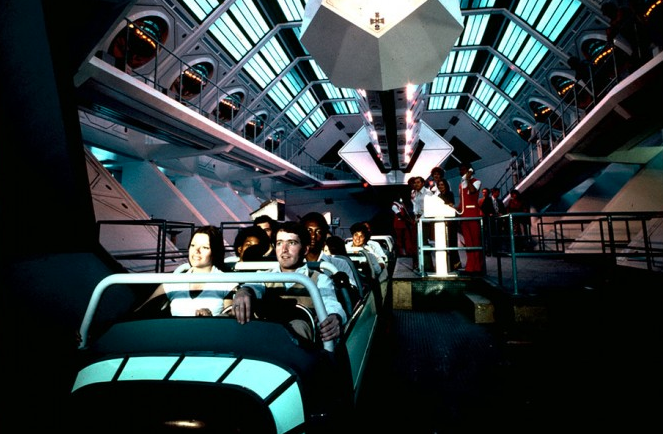
Dispatched from the hangar, the first major change is instantly clear: rebuilt from scratch in 2005, Disneyland’s Space Mountain features synchronized on-board audio scored by Disney favorite Michael Giacchino (who also scored Alias, Lost, and The Incredibles). This invaluable addition turns the ride into an emotional experience rather than just people shrieking in the dark.
The orchestral music at once overwhelms the train as the rockets round the corner and climb a small lift hill, where glowing bars of light pulse and energize the train. Then, a version of Florida’s blue energy corridor follows. But next, the ride enters its main lift hill – a tunnel completely enclosed in projections. As the train engages with the lift, a massive swirling galaxy develops at the top of the lift, and the tunnel around is overcome with swirling coordinates, turning the hill into a dizzying optical illusion.
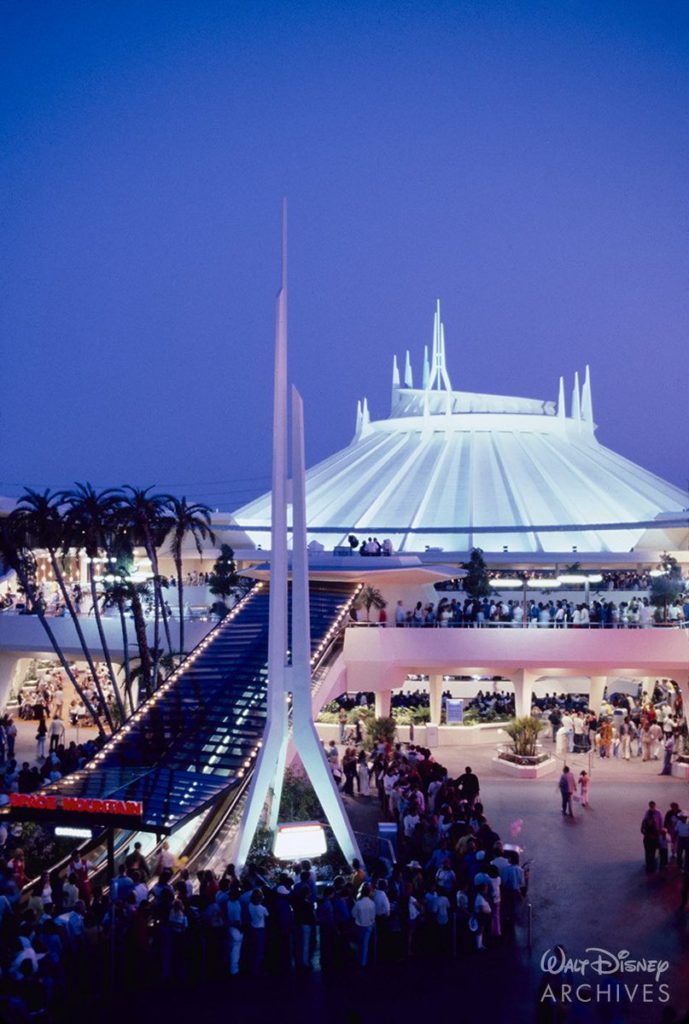
Emerging from the lift, a grand musical crescendo follows. Now set adrift in outer space, the train engages with a final small lift as the voice of ground control counts down: “You are go for launch… in… 5… 4… 3… 2… 1…” Now, the melody changes, and Giacchino’s signature retro-inspired electronic spy score kicks in. It syncs to every dip, turn, and hop in the track, as Space Mountain dives and twists. The ride is faster, longer, and much smoother than Magic Kingdom’s, with an original layout and original special effects.
For better or worse, Disneyland’s updated Space Mountain also means its easy adaptable. Each Halloween, the ride becomes the chilling Space Mountain: Ghost Galaxy, with a malevolent nebula dramatically appearing on the lift, then proceeding the chase riders through the peak in surprising projections in the darkness. The ride was also the first to feature the Star Wars Hyperspace Mountain overlay – made easy by a simple swap in audio and projections.
Space around the world
Naturally, the success of Space Mountain meant its placement in future Disney Parks was assured. And even more so, that it would be given prime real estate in its next installations… On the last page, we’ll explore the ways that Space Mountain and evolved over the decades as it found its way to parks in the ’80s, ’90s, and 2000s – long after the “Space Age” was over! Read on…



